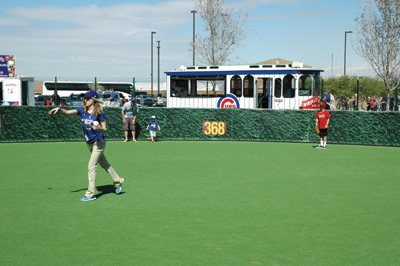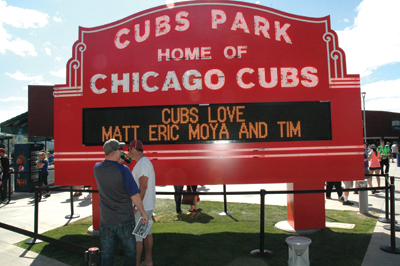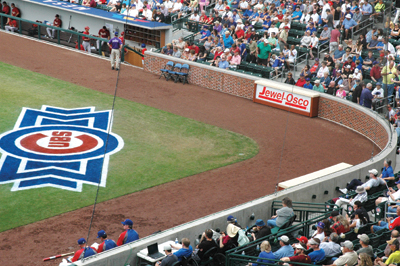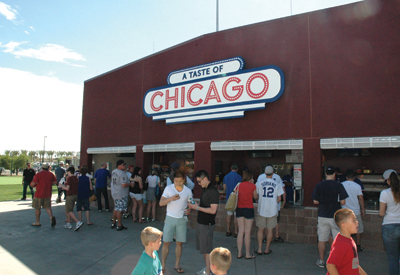The Chicago Cubs’ vision was to create “Wrigley Field West” at their new Arizona spring training facility. With Cubs Park, they got it done for $84 million.
The investment covers the 65,000-square-foot Under Armour Performance Center next door to the ballpark, containing the Cubs’ weight training and conditioning center, connected to six outdoor practice fields and 12 batting tunnels. The new complex consolidates all of the Cubs’ spring major league and minor league facilities, once split between HoHoKam Park and Fitch Park down the street.
 |
Cubs Park is already rewriting single-game attendance records for the Cactus League.
Photo by: DON MURET / STAFF
|
The city of Mesa, which paid for the project after the Cubs signed a 30-year lease, got its money’s worth to keep one of baseball’s top draws in town for spring training, said Dave Bower, a principal at Populous and project director for Cubs Park. On opening day, Feb. 27, the announced crowd of 14,486 set a Cactus League attendance record, and the Cubs have pushed the mark up several times since then toward the ballpark’s capacity of 15,000.
“You can spend a lot more money on these things certainly, and there are examples of where they have before,” Bower said. For example, 3-year-old Salt River Fields at Talking Stick, spring training home of the Arizona Diamondbacks and Colorado Rockies, cost $200 million.
“To bring a project of that size and magnitude on budget, we felt it was very successful,” Bower said. “Could we have done more with more money? Absolutely, but that’s not the most important thing.”
At Cubs Park, that money went toward paying homage to the team’s beloved 100-year-old ballpark, while going light on the kitsch.
One of the best examples of the Wrigley influence is the view from behind third base looking toward the batter’s box. Hanson Brick of Charlotte, the manufacturer for Wrigley’s brick wall behind home plate, duplicated its color and pattern at Cubs Park.
For die-hard Cubs fans intimately familiar with the Friendly Confines, the view stirs an odd feeling that they have seen this before. Are we at Wrigley or Mesa?
The Wrigley-like finishes extend from the curves in the steel light structures to the cantilevered roof, from the scoreboard clock to the steep angle of the grass berm in center field intended to mimic the steepness of Wrigley’s bleacher structure.
Depending on whom you talk to, the Eighteen76 deck, a general-admission space above left field branded for Budweiser, tips its hat to Wrigley’s bleachers or to the controversial rooftops facing the historic Chicago ballpark. In Mesa, those tickets cost $8 to $12 a game depending on opponent.
In addition, the red marquee sitting on the Cubs Park concourse is a smaller replica of Wrigley Field’s most recognizable landmark. Situated along the first-base line, fans can have their customized messages displayed for free on the marquee’s LED board.
The kids’ whiffle ball field beyond center field has its outfield wall emblazoned with graphics depicting Wrigley’s ivy, another of the original ballpark’s unmistakable icons. The Cubs even sent their branded trolley car to Mesa. It’s typically seen outside the Chicago park.
Populous designed HoHoKam Park, the Cubs’ old spring training facility, around the same Wrigley Field theme, and carried it over to Cubs Park. “What you do is drill down, what they wanted here that reminds them of Wrigley,” Bower said. “Ideally, you take that [center-field] shot over the right shoulder of the pitcher — you know it’s Wrigley.”
The Chicago flavor extends to
concessions, too. Eighty to 90 percent of the selections are Chicago-themed, including Vienna Beef hot dogs and Old Style beer, said Ken Young, president of Ovations Food Services, the park’s food and retail provider.
Giordano’s, the Chicago restaurant that recently became the Cubs’ official pizza at Wrigley Field and Cubs Park, has a food truck stationed outside the ballpark.
 |
From top: The brick behind home plate came from Wrigley’s supplier; the Chicago vibe extends to food; the Cubs trolley makes a stop near the ivy-like graphics on the wall of the whiffle ball field.
Photo by: DON MURET / STAFF
|
On opening day, the company distributed free slices of cheese pizza to fans entering the stadium.
The food truck was a way to kick off the partnership after the deal was signed too late for Giordano’s to be served inside Cubs Park this year, said Justin Piper, the Cubs’ general manager of spring training business operations.
Even with the Wrigley touches, Cubs Park maintains a distinct Arizona feel. It can be seen through its red clay-colored exterior walls, the citrus grove that’s a highlight of the picnic area behind the lawn seats, and design “points” jutting from the roofline above the main grandstand.
The roof points are an architectural element Populous brought over from HoHoKam, Bower said. It is also a signature feature at other Cactus League facilities such as Camelback Ranch in Glendale.
The roof cover itself lends a functional piece to Cubs Park. It provides shade to about 70 percent of the park’s 9,200 fixed seats, a critical feature in the Arizona sun. “They looked at other spring training facilities that don’t have that and this was a big hit for them,” Bower said.
One Arizona food brand has a large presence at Cubs Park. Dos Gringos, a Mexican restaurant operating four Phoenix locations, has its name attached to a large covered bar in right field featuring multiple flavors of frozen margaritas.
“It’s not just replicating Wrigley,” Piper said. “You’re getting a unique Cactus League experience, which is what we wanted, a blend of both elements.”
Dos Gringos was packed on opening day, and Ovations expects it to remain a popular destination for the rest of spring training.
The same should hold true for the Eighteen76 deck. The deck’s sight lines overlooking the field are among the park’s best. The setup is similar to the Green Monster seating deck at JetBlue Park, the Boston Red Sox’s spring training facility in Fort Myers, Fla.
Cubs Park has six suites, but none are sold externally. The city of Mesa, which publicly funded the project, has control over two suites and the Cubs reserve the other four for their corporate partners, Piper said.
“Our focus was more on the party decks on the first- and third-base side,” he said. “In the spring in Arizona, people want to be outside.”
 |
The Cubs display fans’ messages on a smaller replica of Wrigley Field’s famous marquee.
Photo by: DON MURET / STAFF
|
Both party decks have roof cover. Combined, they hold about 800 people, and can be split up into smaller spaces depending on demand.
The Cubs market the two decks as an all-inclusive ticket for groups of 20 or more. Tickets cost $40 to $44 a person depending on the day of the week. Both decks are sold out for the season, Piper said. They have a combination of bleacher seating and portable chairs.
“One emphasis the Cubs placed on this park is how to get groups of 100 to 150 people into the ballpark and experience it in different ways,” Bower said. “These big patio areas can fit any denomination. It provides flexibility and you can get more capacity up there.”
The 4,000-square-foot Cubs Team Shop in the right-field corner is one of the biggest retail stores in the Cactus League. A smaller team store is in the left-field corner.
The open concourses keep fans connected to the game. Those pathways run 36 feet to 50 feet wide, which on opening day were spacious enough to avoid crowding in a full ballpark, Piper said.
In that sense, there’s no duplicating Wrigley’s cramped concourse below the stands. In Chicago, improving those pathways is among the issues the Cubs are addressing for the proposed $300 million ballpark renovation.








